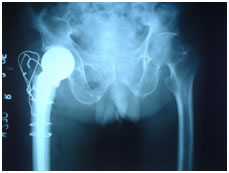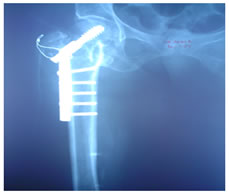Official Journals By StatPerson Publication
|
Table of Content - Volume 3 Issue 3 - September2017
Management of unstable intertrochanteric fractures in the elderly: Osteosynthesis vs hemiarthroplasty
Athar Ahemad1, Ritesh Pathak2*, Nasser M A3
1,2Associate Professor, 3Assistant Professor, Indian Institute of Medical Sciences and Research, Jalna, Maharashtra, INDIA. Email: drriteshpathak@gmail.com
Abstract Unstable intertrochanteric fracture in the elderly is still an unsolved problem with often suboptimal outcomes. 40 patients were treated either by osteosynthesis or hemireplacement and their postoperative function and complications were evaluated and compared. The time taken to be full weight bearing and pain relief were better in the osteosynthesis group in the short term. However, there was no statistically significant difference between the two options on final follow up. The patients with a preexisting comorbidity had a poorer outcome. Key Words: Osteosynthesis, hemiarthroplasty.
Intertrochanteric hip fracture is a catastrophic injury in the life of an elderly individual leading to significant morbidity and mortality. The implants used in the fixation of intertrochanteric fractures have undergone a continuous evolution from the time of Smith-Peterson nail to the Richard’s hip screw and recently the endoprosthetic replacement. The use of endoprosthetic replacement is feasible in a patient who is senile, osteoporotic and whose medical status makes it essential that early ambulation be guaranteed. With internal fixation, the problem of poor implant purchase in the porotic bone of the elderly patient precludes early weight bearing which in turn leads to complications of prolonged bed rest like pressure sores and pneumonia. The use of cemented endoprosthesis gives immediate stability and early ambulation. On the other hand, internal fixation has stood the test of time and has the advantage of retaining the natural head. In the present study, we have set out to compare the functional recovery of patients treated with primary hemiarthroplasty against those treated with dynamic hip screw fixation and to study the complications arising there from.
MATERIALS AND METHODS 40 Elderly patients with communited intertrochanteric/basitrochanteric fracture who were able to walk prior to injury are reviewed. The mean age of patients was 68 years. They were divided into two groups; one treated by osteosynthesis (DHS system) and the other by hemiarthroplasty (bipolar/Austin-Moore prosthesis) and the functional results were evaluated using Harris hip scores. 8 patients died within four months of follow up. The patients were followed up for an average duration of 9.3 months ranging from 3 to 18 months. Treatment protocols:
Hemiarthroplasty
Figure 1: Radiograph showing hemi arthroplasty for an unstable intertrochanteric femur fracture. Note the wiring of greater trochanter fragment.
Dynamic hip screw: The patients were operated in supine position on a fracture table. Standard surgical technique was used (which need not be detailed here).
Figure 2: Unstable intertrochanteric fracture fixed with dynamic hip screw. Post operative protocols: Hemiarthroplasty: Patients were started on active or active assisted straight leg raises and abduction exercises from 2nd P.O. day. On 4th PO day, full weight bearing walking with the help of walker was attempted and continued. Patient was later weaned to a tripod walking stick and then to walking full weight bearing without support. Osteosynthesis: Static quadriceps exercises are started on day 1 P.O. Dynamic quadriceps exercises and abduction exercises commenced from 2nd P.O.day onwards. Patients were mobilized nil weight bearing on axillary crutches after adequate limb control was achieved. This was preceded by gait training on walker in frail patients. Weight bearing to tolerance was allowed from 2th week onwards and weaned off from crutches. On follow up visits, hip function was evaluated by Harris hip scores11.
RESULTS In this series, 40 patients of unstable intertrochanteric fracture i.e. Tronzo’s type III and type IV were studied. 20 patients were treated with anatomic reduction and internal fixation with dynamic hip screw with/without wiring of the fractured greater trochanter. 20 patients were managed with primary cemented hemiartroplasty [Bipolar prosthesis in 9 and Austin Moore prosthesis in 1(case no.6a)] The mean follow up of patients was 9.3 months ranging from 3 month to 18 months. The overall age of the patients was 68.05 years. In hemiarthroplasty group, the mean age was 72.5 years as compared to 63.6 in DHS group. 55% of the patients were male and 45% were female. FRACTURE PATTERN: Tronzo’s classification was used1,3.
Table 1: Type of fracture
The majority of fractures were of type III variant. 40% of type III patients were treated with bipolar hemiarthroplasty and 60% were treated with dynamic hip screw. Half of type IV patients were in hemiarthroplasty group and half in DHS group SURVIVAL: 8 patients have died during the study all within 4 months after surgery. Four of them were treated with bipolar prosthesis and four were fixed with dynamic hip screw. The mortality rate was 20% in our patients which is comparable to other series like Vidal et al (20%) and Haentjens et al (30%)7,12. A 75 year old male patient (case 7a) died 4 days postop due to aspiration pneumonitis. Other patients died of causes unrelated to surgery. Correlation Between Trauma-Surgery Interval and Pressure Sores: All pressure sores had developed preoperatively in 4 patients and the average trauma-surgery interval was 26.5 days. Trauma-surgery interval was longer in those patients who had poor general health and associated medical conditions and high ASA grade of anesthesia risk.
Table 2: Blood Loss and Operative Time
The average blood loss and operative time was higher in patients treated with osteosynthesis but the difference is within 95% confidence limits.
Table 3: Effect of Pre-Existing Diseases on Functional Outcome
The presence of pre-existing diseases along with the intertrochanteric fracture had an adverse impact on functional outcome leading to poor Harris scores (54.16).The patients without any pre morbidity mobilized well and had better Harris scores (71.07).
Table 4:
Table 5: Complications
Infection: We had 2 cases of infection (5%) in which one was a deep infection and one was superficial.
Dislocation of Bipolar prosthesis: One case of dislocation occurred in our series (5%) which compares favorably with the incidence in other reports (Haentjens et al-6%, Vidal et al -7%, Stern and Goldstein- 10%). Dislocation occurred due to fall while walking 2 weeks post operative to bipolar hemiarthroplasty in a 65yr/female. Closed reduction and immobilization was done. She died 2 months postop of unrelated causes. Pressure sores: 4 patients had developed pressure sores (20%) related to a longer trauma-surgery interval in these patients (26.5 days) due to poor general health and associated medical diseases. All sores had occurred before surgery and were unrelated to the modality of treatment. Aspiration pneumonia: One patient (case 7a) died of aspiration during a bout of vomiting 4 days postop. He also had parkinsonism, cerebral infarcts and diabetes. Adduction contracture: One patient (case 10a) developed an adduction contracture after bipolar hemiarthroplasty due to excessive anteversion of prosthesis. There were no cases of limb length discrepancies or loosening of prosthesis after hemiarthroplasty.
Table 6: Time to Walk Full Weight Bearing
The time taken to walk full weight bearing was significantly greater in osteosynthesis group (p<0.05) as compared to hemiarthroplasty. It allowed a rapid return to activities of daily living and made the patients independent. FUNCTIONAL OUTCOME: The functional outcome was evaluated by Harris Scores.
Table 7:
The final Harris Scores did not show statistically significant difference between the two groups. Cemented hemiarthroplasty restores function within a short period of time and allows unrestricted weight bearing almost immediately. The hospital stay is shortened reducing health care costs. Rapid ambulation is essential in elderly, frail patients with poor coordination to prevent further deterioration of their health status.
DISCUSSION The Dynamic hip screw is currently very widely used as a reliable device for internal fixation of intertrochanteric fractures. However, it has its own problems. It is not always easy to achieve a stable and/or anatomical reduction in cases of severe communition or osteoporosis. The poor mechanical properties of weak and porotic bone in the geriatric patients do not usually provide a firm purchase for the screws. It has been recommended that the hip be protected throughout the healing period in the patients of unstable intertrochanteric fractures. So, early full weight bearing cannot be advised in such patients without the risk of implant failure or loosening. In order to enable early walking with full weight bearing, primary hemiarthroplasty can be used in elderly patients with age more than 60 years who have unstable intertrochanteric fractures of the hip. The cement-prosthesis-femur complex has excellent stability and high load bearing capacity allowing early resumption of full weight bearing ( Sonstegard et al)2. Other authors have reported good functional outcome, rapid rehabilitation and a low rate of complications with primary hemiarthroplasty (Tronzo et al, Pho et al, Haentjens et al, S.Green et al, Stern and Angerman et al, Chan and Gill et al, etc.)3-8. In the current series, elderly patients (age>60 years) who were ambulant prior to injury with unstable intertrochanteric fractures were treated with a dynamic hip screw fixation or a primary hemiarthroplasty. The results were compared using Harris hip scores. It was found that the patients of hemiarthroplasty walked full weight bearing significantly earlier than those of osteosynthesis group (p<0.05) allowing rapid rehabilitation. We observed that the arthroplasty patients were able to bear full weight earlier with the aid of walker on the involved limb whereas those who had had internal fixation had to restrict weight borne on the affected limb. The duration of use of walking aids was also recorded during follow up and was reflected in the Harris hip scores. It was also noted in this series that that the patients of cemented hemiarthroplasty were relieved from pain much earlier than those who had osteosynthesis resulting in better scores for the former. As the fracture healed in subsequent follow ups, the patients of internal fixation also had more pain relief and better weight bearing on the affected side and their hip scores also improved. Hence the final mean Harris scores of the two groups ( DHS=67.9 and Bipolar=62.29) were not significantly different (p>0.05). It cannot be concluded at the end of present study whether hemiarthroplasty or osteosynthesis is the better option in the long term. It can be suggested that long term studies with larger number of patients would be required to reach a more unequivocal conclusion. The amount of blood loss during surgery and the operative time required in both the groups were not statistically different (p>0.05). This serves to show that hemiarthroplasty is neither longer nor bloodier a surgery than internal fixation (DHS). The final outcome was better in those patients who did not have a pre-existing disease prior to fracture and also had less complications. They had better Harris scores (mean 71.07) than those with premorbidity (mean 54.16). Neither option is better than the other in the long run. The procedure needs to be tailored to the patients condition considering the age, bone quality and premorbidity. Since it provides earlier pain relief and faster weight bearing, cemented hemiarthroplasty is a suitable alternative in elderly patients with osteoporosis and other pre-existing diseases for the treatment of unstable intertrochanteric fractures.
REFERENCES
|
|
 Home
Home


